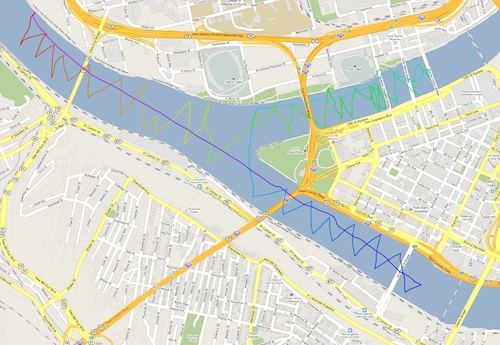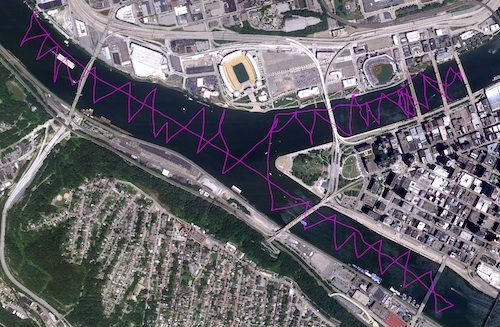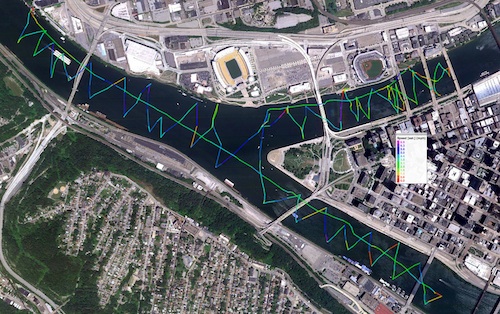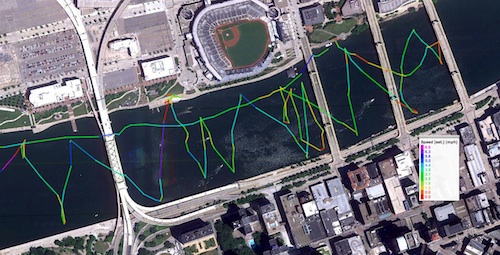Winds from the South East
September 11, 2010
In my sailing this summer, I've concentrated on understanding better how the winds blow on the rivers around the Point. Most of my sailing this and last summer was with winds coming from the West. It's time to expand my range of experience, so I've been waiting for East winds to blow. They finally came this Saturday for a brief window in the afternoon.
The forecast called for 9-10 mph hour winds from the East South East and South East. That meant that the winds would be blowing with the current. It is a configuration that is dangerous if there is a significant current. When wind and water move together, a sailboat has fewer means to gain against the current. In the worst case, the two move at the same speed and a sailboat will be becalmed, while the current washes it away. All this is explained here.
Forunately, as is common later in the summer, the currents were low: around 6,000 cubic feet per second on the Ohio, around 4,000 cubic feet per second on the Allegheny and much lower still on the Mon and Yough. So it seemed that I could sail without thinking too much about the strength of the current.
On the bicycle ride over to the marina in the afternoon, the conditions seemed good. I measured winds all the way from dead calm to 12 mph. That was a mixed result, but it afforded enough promise of a good day sailing. What was not mixed was the splendid early September sky. We had temperatures in the mid 70s and lots of happiness on the riverbanks.
A Steelers' game was underway and, from time to time, a great roar would flood out of Heinz Field over the water. Two boats of the Gateway Clipper fleet were docked at the Field, ready to ferry fans back after the game.
Smaller boats were docked three and more deep and the party on the riverbank was well underway.
My expectation was that an ESE wind would blow consistently up the Mon and along the Ohio Rivers, past where I keep my boat at the Newport Marina. For the river courses of Mon and Ohio Rivers here are aligned in that direction. There's nothing to block the winds blowing straight along them. When I arrived at the marina and checked the conditions, that seemed to be right.
Putting into the water, I found the good steady headwind expected, blowing from the Point. I began the laborious job of tacking to and fro into it, gaining a little way with each tack. It took about 45 minutes to reach the Point, about twice the time needed when I run with good Westerly winds behind me to the Point.
The story is best told by the gps tracks:
The sail up to the Point starts in the top left hand corner. Its zig zag course was fast and fun, as I tacked into a steady head wind. As I neared the West End bridge, the winds shifted briefly from their ESE direction directly upstream to a more Easterly direction. Perhaps they were deflected around the bridge--I could not tell. The change is reflected in the way the zig zag of the tacking deflects just before the bridge:
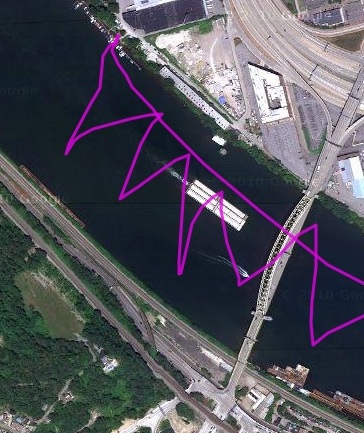
My expectation was that the good winds would continue up to the Point, but they would not persist on the Allegheny, once the buildings of Downtown began to block the East South East winds. On the first stretch of the Allegheny, the winds remained steady. If anything they were strengthening.
The gps track coded for speed shows a good burst of speed over 6 mph just past the Fort Duqesne Bridge. It sent me hurtling towards the shore. I was wondering if I could make the tack, when I realized that there was perfect place to beach dead ahead. I'd been on the water about an hour now and a break seemed inviting. So I beached and took a simple lunch of walnuts, dried cranberries and a protein bar. It is my sailor's food since it is easy to grab on the way out the door and throw in the Bravo's locker. I suppose nautical hard tack with weevils would be more authentic, but on some points I am willing to compromise.
Shortly after, I watched a riverboat glide past.
After this little break, I put back into the water and headed upstream. In the short time of my break, the winds had weakened to slight breezes. As I continued sailing, they weakened further until I came just short of the 6th Street Bridge. I could go no farther upstream. I sailed to and fro trying to get farther, but failed. Here's a detail of speed-coded gps track:
My first thought was that, with the winds weakened, the current was too strong for my meager speed to beat. It seemed to be the problem since my bows were pointing slightly upstream and I was moving, but not gaining in relation to the riverbank.
However, now that I've had a chance to check the gps tracks and do some sums, I'm not so sure that is right. At 4,000 cubic feet per second, the current is moving at a mere 0.15 mph on my estimates. The gps track shows that my linear speed was in the 0-2 mph range. That should have been plenty to beat the current, even allowing that only a portion of that speed could be directed against the current upstream. So I remain puzzled by the event. Perhaps the river is constricted at here by the bridge sufficiently to increase the linear speed well above the .15 mph I expected?
After ten minutes of fruitless efforts, the wind returned just enough to let me press my way upstream. You'll see when I break free; my track moves upstream diagonally at a steady 3mph. The goal I set was the 9th Street Bridge. When I arrived, the winds seemed even lighter and the water had grown glassy.
It was calm enough for me to furl the sail and take some photos, including the last one of the glassy water. During the short time (perhaps 5 minutes) that I lay on the deck with the sail furled taking a few photos, the boat moved noticeably downstream, as this portion of the gps track shows:
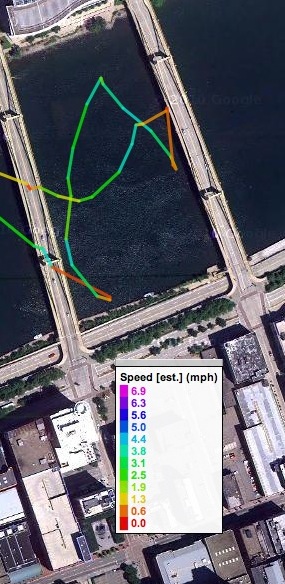
Perhaps this was just the effect of the little wind there was, blowing on the bare pole of the mast and the hull. Or perhaps there was more linear speed in the current than I'd computed above. Or perhaps it was both.
Back to the photos: here's the underside of the bridge. I'll admit it--it is still enthralling to have these great spans pass over my head as I sail through.
Here's the view back downstream.
With these photos taken, I unfurled the sail and headed back to the Point, stopping for a moment at the dock between 6th and 7th Street. The winds driving me back were gentle.
So far, things were going as expected. The winds on the Allegheny were weaker and more erratic than on the Ohio. It is what should happen to an ESE wind that is blocked by the tall buildings of Downtown.
When I approached the Point, the winds were growing steadier, as one would expect for ESE winds. They should blow up the Mon and Ohio without obstruction by hills or buildings. I rounded the point and began tacking up the Mon into the wind. The gps tracks show clearly that the winds on the Mon were much more consistent. The tracks on the Allegheny are irregular and tortured, as I struggled to make way; the tracks on the Mon have the regularity of a text-book image of tacking into the wind.
I made it just past the wonderful old Smithfield Street Bridge. It was getting late, so I knew it was time to head home. Winds sometimes die later in the afternoon and, if that happens, being too far from home is not good. There was time to take some photos.
One looks upstream to where I'd seen another sailboat in the distance a week ago:
Another looks downstream at the Smithfield Street Bridge:
Looking under that bridge, I could see all the way to the West End
Bridge. That is where I would now head to end this little voyage.
It would take about 45 mintues, running gently with the wind behind
me, before I would settle my boat on its ramp at the river's edge.
John D. Norton
Back to main
